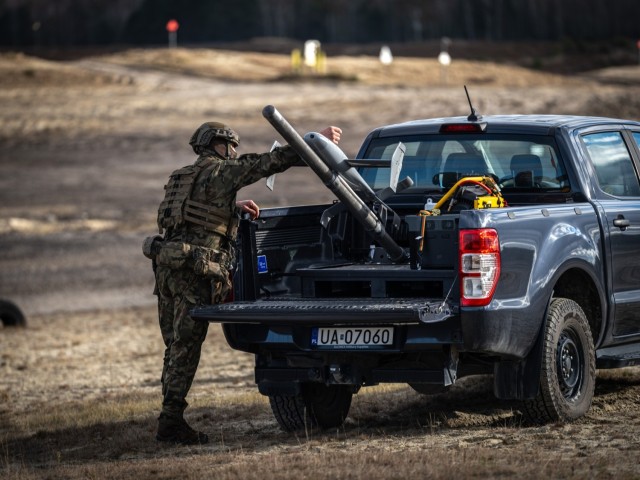
NOWA DĘBA, Poland — U.S., Polish and Romanian Soldiers demonstrated a new counter-unmanned aircraft system capability on Nov. 18, underscoring how Allies are adapting to the growing drone threat along NATO’s eastern flank.
The live-fire event at the Nowa Dęba Training Area capped a two-week course that brought together air defenders from all three nations. Soldiers trained on a mobile system that uses radar, electro-optical sensors and a small interceptor drone to detect, track and defeat hostile unmanned aircraft.

All major components fit on a light tactical vehicle or pickup truck, allowing a four-person crew to move, emplace and reload the system in minutes. During the demonstration, crews used a truck-mounted launcher to fire interceptors against surrogate “enemy” drones and recover them by parachute for reuse in training.
“It’s very lethal, very effective, but the key piece here is that it’s cost effective,” said Brig. Gen. Curtis King, commanding general of the 10th Army Air and Missile Defense Command.
King noted that the same type of interceptor has already been used in combat in Ukraine against Russian unmanned systems. There, he said, the capability has been “highly effective and lethal against one-way attack drones in Ukraine,” and is part of “the latest technology that’s being fought in Ukraine right now.”

Because the interceptor is designed as an expendable munition, the system allows commanders to engage low-cost drones without expending long-range interceptors needed for aircraft, cruise missiles or ballistic missiles. Combat use in Ukraine has provided Allies with real-world performance data before fielding the capability on NATO soil.
Polish and Romanian officers at Nowa Dęba said recent airspace violations and drone incidents over their territory accelerated efforts to field practical counter-UAS options.
The course followed a train-the-trainer model. U.S. Soldiers from 1st Battalion, 57th Air Defense Artillery Regiment trained alongside Polish and Romanian counterparts through classroom instruction, simulator work, and live launches. Graduates are expected to form the core of future national training teams.

The training and demonstration in Nowa Dęba support NATO’s Operation Eastern Sentry and the Eastern Flank Deterrence Line, which seeks to link ground-based air and missile defense, aviation, sensors, and fires into a layered architecture along NATO’s flank. Short-range counter-UAS systems like the one exercised in Poland provide a first line of defense against unmanned aircraft and help preserve higher-end interceptors for more complex threats.
By integrating this capability with allied training and planning, U.S., Polish, and Romanian air defenders are improving readiness and reinforcing deterrence, ensuring NATO can detect, track, and defeat the growing drone threat across the eastern flank.
For more information and updates on 10th AAMDC’s operations, follow us on Facebook, Instagram, Linked In and X.




Social Sharing